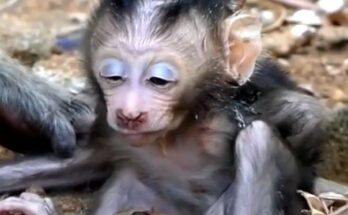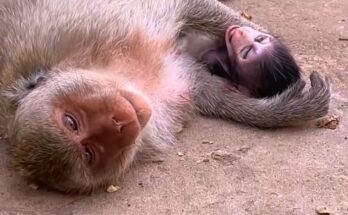In the wild world of the jungle, emotions aren’t just a human trait. A surprising and deeply moving encounter has brought this truth into sharp focus. When a group of langur monkeys encountered a robot monkey designed to look and act like one of their own, their reaction was nothing short of astonishing. What began as simple curiosity evolved into what appeared to be profound empathy — a display of emotional depth rarely documented in such a striking manner. The event revealed that bonds within primate groups go far beyond instinct or survival; they touch on the very essence of emotional connection.
The robot monkey was introduced into the langurs’ troop as part of a wildlife documentary experiment. Equipped with realistic movements, sounds, and facial expressions, the robot was accepted as a juvenile by the troop. The langurs approached the robot cautiously at first but eventually began to interact with it — grooming, cuddling, and treating it with the same tenderness they would offer a living member of their family. These early interactions were filled with affection and social bonding behaviors typical among langurs, highlighting their willingness to include what they believed was a new young member in their group.
However, the emotional heart of the story unfolded when the robot monkey was accidentally dropped and remained motionless. What followed was not just confusion, but an intense, visible reaction of distress from the langurs. They gathered around the fallen figure, touching it gently, peering into its lifeless face, and making soft vocalizations — as if mourning a death. Several monkeys sat close to the robot in silence, while others reached out to comfort each other. This collective mourning behavior, which closely mirrors how humans respond to loss, was both stunning and heartbreaking.
This moment revealed the extent of emotional intelligence present in langurs. Far from being guided only by instinct, these monkeys showed the capacity for grief, confusion, and possibly even understanding of death. The experiment inadvertently uncovered something raw and incredibly human in these wild animals — the ability to form deep emotional bonds and to suffer when those bonds are broken.
Experts who observed this moment noted how it challenges traditional views of animal behavior. It supports a growing body of research suggesting that primates, and many other animals, are far more emotionally complex than once thought. Their reaction to the robot monkey wasn’t just mimicry or learned behavior; it was spontaneous and sincere, echoing the same emotional chords found in human communities faced with sudden loss.
The langurs’ emotional reaction to the robot monkey opens up a profound question: How much more do animals feel than we give them credit for? In their quiet grief and tender gestures, these monkeys reminded us of a powerful truth — empathy and emotional bonds aren’t uniquely human. Sometimes, they exist where we least expect them, in the hearts of those who cannot speak but clearly feel.


